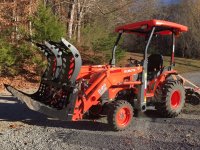jeff9366
Super Star Member
- Joined
- Jan 14, 2011
- Messages
- 12,787
- Tractor
- Kubota Tractor Loader L3560 HST+ ~~~~~~~~~~~~~ 3,700 pounds bare tractor, 5,400 pounds operating weight, 37 horsepower
Can a B or BX handle a disk and if so what size. I want to use it for small food plots. 1 acre plot is my largest
The lightest Tandem Disc Harrow which is effective creating food plots has pans 20" in diameter.
Such a Disc Harrow requires a 4-WD drive tractor with a bare tractor weight of 3,300 pounds and moist soil conditions. Any Disc Harrow lighter requires six to ten passes over new ground to scuffle the surface enough for seeding medium and large seeds most common in fall/winter food plot mixes, such as winter wheat and oats.
A Disc Harrow must be pulled at a brisk pace in order to mix and level soil. Two (2) range HST equipped tractors are impossibly handicapped.
Disc Harrows and PTO-powered roto-tillers are both soil mixers. A 1,500 pound Kubota BX or B weight tractor with minimum 23-horsepower can effectively handle a forward rotation roto-tiller somewhat wider than the rear tires mixing moist soil. I recommend a roto-tiller for mixing soil with a 1,500 - 3,000 pound bare weight tractor.
MORE: disc harrow vs rototiller site:tractorbynet.com - Google Search
Multiple reasons owner/operators trade up from Subcompact Tractors:
More tractor weight.
More FEL lift capacity.
Three-range (3) HST (Lower LOW, Higher, HIGH) ~~ rather than two-range (2) HST.
More ground clearance.
Larger wheels and tires have a larger tire/tread "patch" in contact with the soil. Larger wheels and tires bridge small holes, ruts and tree debris maintaining traction, which stall subcompact tractors. As a result, larger wheels/tires yield more tractive power pulling ground contact implements and logs, pushing a loader bucket into dirt and pushing snow. Larger wheels and tires decrease operator perturbation operating over rough ground.
Last edited:

